Want to get more from leg day without running yourself into the ground? This guide shows how to use the leg press to build size and strength without burning yourself out.
Some fitness “gurus” say squats are all you need to build strong, muscular legs.
They’re wrong.
Squats are excellent, but they’re also highly fatiguing—especially on your lower back—which limits how often you can do them each week before your joints cry uncle.
That’s why smart weightlifters pair squats with exercises like the leg press, which allow you to train many of the same muscles with heavy weights, but without beating up your body as much.
That said, the leg press isn’t foolproof. If you want to get the most out of it while remaining injury-free, you have to learn proper leg press form.
In this article, you’ll learn everything you need to know about the leg press exercise, including what the leg press is, its benefits, how to use the leg press machine, and more!
Want to know exactly how you should train to reach your fitness goals? Take our free 60-second training quiz and find out now
Key Takeaways
- The leg press is a machine-based lower-body exercise that primarily trains your quads and glutes. It also trains your hamstrings and calves to a lesser extent.
- It’s less fatiguing than free-weight exercises like squats, making it ideal for when your back is tired or injured.
- Placing your feet high on the footplate may slightly increase glute and hamstring activation, but the differences are small.
- The single-leg leg press can help fix muscle and strength imbalances between sides and reduce stress on your spine while still allowing you to train hard.
- For an effective leg press workout, do three sets close to failure of the leg press, Romanian deadlift, lunge, and calf raise.
- To get the most out of your leg press training, consider using a high-quality protein powder to help you reach your daily protein target, creatine to support recovery and muscle growth, and a pre-workout to enhance energy, focus, and performance.
Table of Contents
+
What Is the Leg Press?
The leg press is a lower-body exercise that involves sitting in a seat and pushing a weight away from your body using your legs.
You usually perform it on a leg press machine, with the two most common types being the “seated leg press” and the “vertical leg press”. While every leg press machine is slightly different, most consist of a padded seat, a footplate, and safety handles.
Here’s an example of what a seated leg press machine looks like:
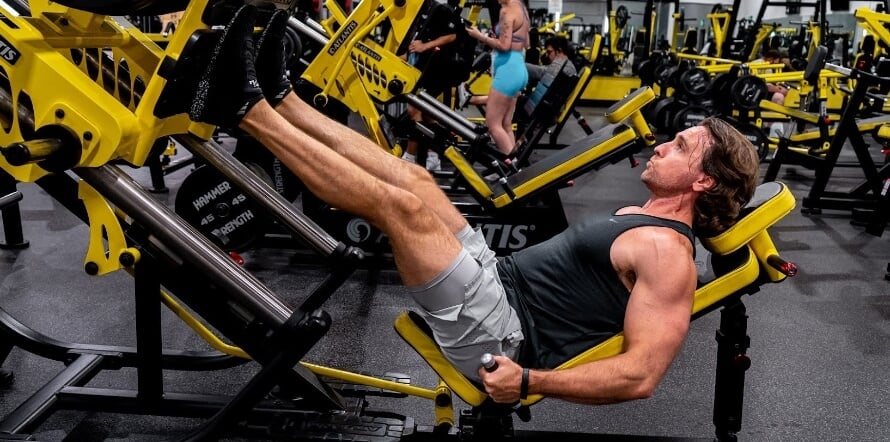
Leg Press: Form
The best way to learn how to use the leg press machine is to split the exercise into three parts: set up, descend, and press.
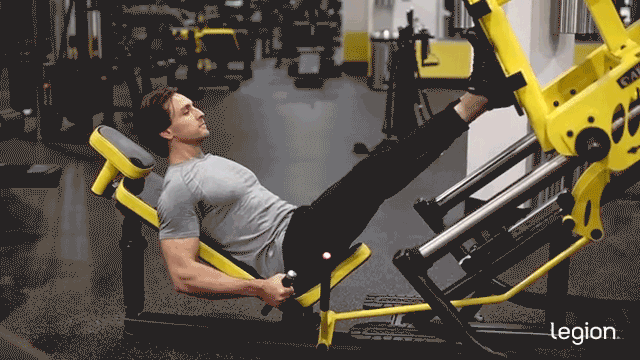
Step 1: Set up
Load a leg press machine with the desired amount of weight, then sit in the seat and wedge your butt down into the base of the seat.
Place your feet halfway up the footplate and a little wider than shoulder-width apart with your toes pointing slightly outward.
Straighten your knees slightly and use the safety handles to release the weight.
Step 2: Descend
Lower the footplate toward your chest until your knees are about 12-to-18 inches from your chest while keeping your butt firmly planted in the seat and without rounding your back.
As you lower the weight, push your knees out in the same direction as your toes.
Step 3: Press
While keeping your back pressed against the backrest, push the footplate away from your upper body until your legs are almost but not completely straight (knees slightly bent) and return to the starting position.
Leg Press: Muscle Worked
The main muscles worked by the leg press exercise are the quadriceps and glutes, though it also trains your hamstrings and calves to a lesser extent.
Here’s how the muscles worked in the leg press look on your body:
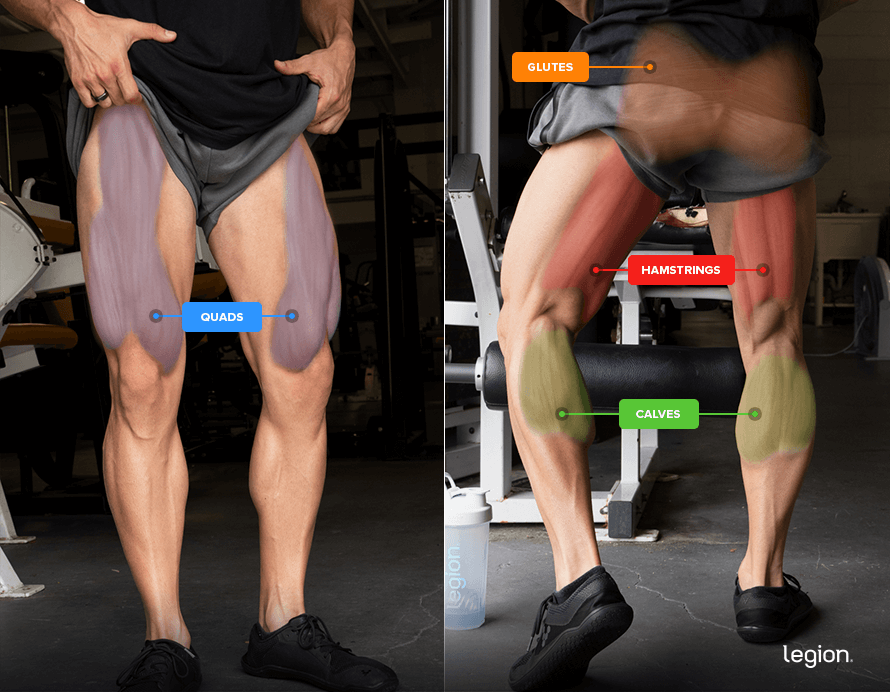
Leg Press: Benefits
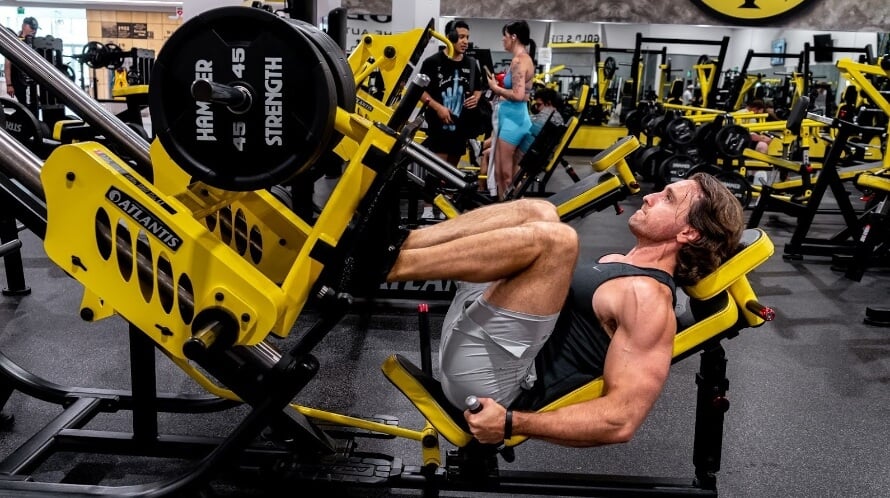
1. It allows you to train your legs when your back is tired.
During many of the best leg exercises, like the back squat, front squat, and Romanian deadlift, your back muscles have to work hard to keep your upper body in a stable, safe, and efficient position.
If your leg workouts only consist of free-weight exercises like these, your back muscles (and particularly your lower-back muscles) may fatigue faster than your legs. In other words, while your back may be bushed after 6 sets of these exercises, your legs may be able to handle a few more.
The leg press is a helpful workaround in this scenario, as it allows you to train your legs (mainly your quads and glutes) after your back is fried.
This ensures you can train your legs with the volume (sets) they need to grow without your lower-back becoming a limiting factor.
2. It’s less fatiguing than other leg exercises.
Generally speaking, free-weight exercises are more effective than machine exercises for building muscle and gaining strength.
However, free-weight exercises also tend to be more taxing on your joints, ligaments, tendons, and central nervous system than machine exercises that train the same muscles, which means you can only do so much before the quality of your workouts dips.
This is especially true when it comes to large muscle groups like the legs and back.
A good way to avoid this is to replace one of your free-weight leg exercises each week with the leg press exercise because this enables you to effectively train your legs without wearing your body to a frazzle.
For example, instead of doing a workout that consists of the barbell back squat, leg curl, barbell front squat, and dumbbell lunge, you could swap the front squat for the leg press. (In fact, this is almost exactly what I recommend in my programs for men and women.)
3. It’s ideal for people with lower-back problems.
Unlike many other compound leg exercises, the leg press doesn’t load your spine (when it’s performed correctly).
This makes it ideal for people who are training around or trying to avoid reaggravating a back injury.
That said, if you perform the leg press incorrectly by bringing your thighs too close to your chest, or if you lack the flexibility to perform it through a full range of motion, you may round your lower back during the exercise.
This places stress on your lower back and may increase your risk of injury. Thus, it’s essential that you perform the exercise correctly.
Leg Press Foot Placement
You may have heard that you can change which lower-body muscles you emphasize on the leg press by altering your leg press stance.
For example, common gymlore stipulates that . . .
- To do a leg press for glutes and hamstrings, you should place your feet high on the footplate.
- To do a leg press for quads, you should place your feet low on the footplate.
- To emphasize your outer quads, you should take a narrow stance.
- To emphasize your inner quads, you should take a wide stance and turn your toes out.
And while this isn’t completely wrong, it isn’t exactly right, either.
For instance, some research shows that performing the leg press with your feet high on the footplate increases glute and hamstring activation, and performing it with your feet low on the footplate increases quad activation.
In both cases, however, if the differences occur, they’re slight, and since higher muscle activation doesn’t always lead to more muscle gain, it isn’t clear how much changing the height of your leg press foot placement affects your long-term results.
Things are less ambiguous when it comes to how stance width and foot orientation affects muscle activation: several studies show that muscle activation in your legs is the same regardless of how wide your stance is or how you point your toes.
Thus, tinkering with your stance width on the leg press won’t make any difference to how much muscle you build or where you build it, though it’s still something you should experiment with to find a width that feels most comfortable for you.
All things considered, the best foot position for most people will be one that has your feet halfway up the footplate and a little wider than shoulder-width apart, and with your toes pointing slightly outward.
This is the most comfortable position for most people as it feels safe and stable and doesn’t require extreme flexibility, making it the best position to start with.
Benefits of the Single-Leg Leg Press (And When to Use It)
The most popular leg press variation is the single-leg leg press (often also called the “one-leg leg press”).
You perform the single-leg leg press the same as the regular version, but instead of pressing the weight with both feet, you train one leg at a time.
The benefits of single-leg leg pressing is that your stronger side can’t compensate for your weaker side, which helps you fix any muscle and strength imbalances you might have.
The single-leg leg press also has a practical perk: because you’re only using one leg at a time, you don’t need to load the leg press machine with as much weight, which saves time during setup and cleanup (which I’m sure you always do).
Some also argue the single-leg leg press is a safer, more comfortable option, since placing one leg on the floor prevents you from rounding your lower back and causing or irritating lower back issues.
At bottom, both the regular and single-leg leg press are effective, so either stick with whichever version suits you best, or alternate between them every few months of training.
Sample Leg Press Workout for Size & Strength
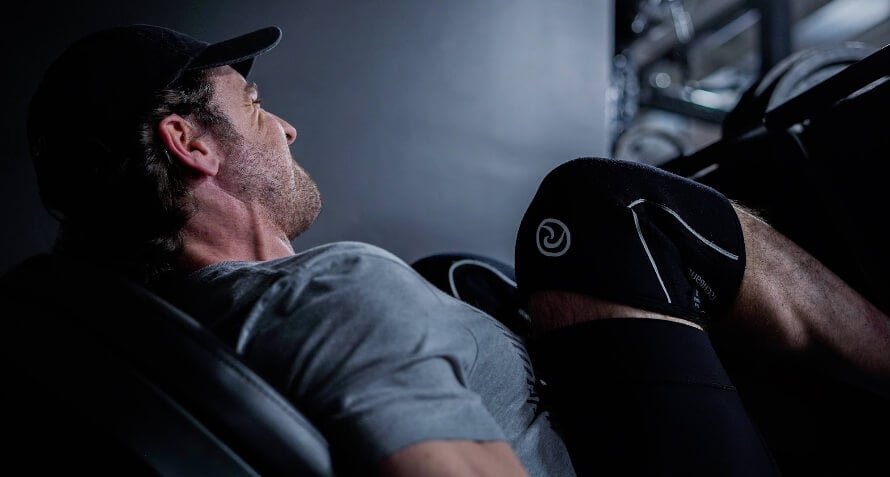
When most people say “leg press workout,” they’re not talking about a routine that only includes the leg press. Instead, they usually mean a lower-body workout that centers around the leg press but includes other key exercises, too.
And that’s the right approach—because to maximize muscle growth, research shows it’s best to train each muscle group using a variety of exercises that train your muscles at different angles and through various ranges of motion.
Here’s a sample leg press workout routine that does just that.
- Leg Press: 3 sets | 4-to-6 reps | 2-to-3 min rest
- Romanian Deadlift: 3 sets | 4-to-6 reps | 2-to-3 min rest
- Lunge 3 sets | 6-to-8 reps | 2-to-3 min rest
- Standing Calf Raise: 3 sets | 8-to-10 reps | 2-to-3 min rest
Supplements to Maximize Your Leg Press Gains
If you want to get the most out of your leg press workouts, consider these three supplements:
- Protein powder: Protein powder, such as Whey+ (Legion’s whey isolate) or Casein+ (Legion’s micellar casein), provides your body with the nutrients needed to build muscle tissue and recover from workouts.
- Creatine: Creatine boosts muscle and strength gain, improves anaerobic endurance, and reduces muscle damage and soreness from your workouts. For a natural source of creatine, try Legion’s creatine monohydrate, creatine gummies, or post-workout Recharge.
- Pre-workout: A high-quality pre-workout enhances energy, mood, and focus, increases strength and endurance, and reduces fatigue. For a top-tier pre-workout containing clinically effective doses of 6 science-backed ingredients, try Legion’s Pulse with caffeine or without.
(If you’d like even more specific advice about which supplements you should take to reach your health and fitness goals, take the Legion Supplement Finder Quiz, and in less than a minute, you’ll know exactly what supplements are right for you.)
The Best Leg Press Alternatives for Size & Strength
To be considered a worthy substitute for the leg press, an exercise must meet three criteria:
- Let you lift heavy weights safely and progress over time
- Train your entire lower body
- Minimize stress on your spine
With that in mind, the best leg press alternatives are:
- Hack squat
- Barbell front squat
- Dumbbell front squat
- Safety bar squat
- Goblet squat
- Bulgarian split squat
- Step-up
- Pendulum squat
- Belt squat
Want to know why these work so well—and how to do each one correctly? Read this next:
8 Leg Press Alternatives for Gym and Home Workouts
One popular option I don’t recommend is the Smith machine leg press. Here’s what it looks like:
It’s awkward to set up, potentially unsafe, and less effective than just doing Smith machine squats or lunges instead.
FAQ #1: How do you perform the leg press for glute growth?
If growing your glutes is a priority, leg press with your feet high on the footplate. Some (though not all) studies suggest this increases glute activation, which may help you gain glute muscle more effectively.
That said, the difference is small. In other words, it’s a low-risk, potentially medium-reward tweak—but it won’t make or break your results.
If placing your feet high on the footplate feels awkward or uncomfortable, stick with a more standard setup: feet in the middle of the footplate, just outside shoulder-width, with toes turned slightly out.
FAQ #2: Leg Press vs. Squat: Which is better?
It depends.
The leg press and squat are both effective exercises for training all the muscles of the legs, though the squat is likely better at training stabilizer muscles across your entire body and secondary muscle groups such as the lower back, and may have more carryover to other athletic endeavors.
That said, many people lack the mobility to perform the squat properly, or can’t perform the squat because of preexisting injuries that make it unsafe to place heavy loads on their back.
For these people, the leg press is a better option than the squat, at least until they develop the mobility to perform the squat with proper form or recover from the injury that makes squatting uncomfortable.
The squat is also very fatiguing, which can make the leg press a better exercise for including at the end of your workout when you’re feeling ragged.
FAQ #3: Leg Press vs. Hack Squat: Which Is Better?
It depends.
The main differences between the leg press and hack squat machines are that the hack squat trains your muscles through a greater range of motion, which is generally better for muscle growth, but the leg press is less taxing on your lower back, which means it’s less fatiguing and may be more comfortable if you’re working around a lower-back injury.
Of course, there’s no reason to choose just one. The best solution for most people is to include both exercises in your program.
A good way to do this is to include the leg press in your program for 8-to-10 weeks of training, take a deload, then replace the leg press with the hack squat for the following 8-to-10 weeks of training.
Then, you can either continue alternating between the exercises every few months like this or stick with the one you prefer.
FAQ #4: What’s the leg press world record?
The leg press isn’t officially tracked in the same way that exercises like the squat, deadlift, and bench press are, which means there isn’t an official world record leg press.
That said, William Cannon set an unofficial leg press world record of 1,120 kilograms (2,470 pounds) for a single unaided rep using both legs in September 2021.
FAQ #5: Can you do the leg press at home?
Unless you have a leg press machine, no, you can’t do a “home leg press.”
That said, there are many good leg exercises you can do at home that train your legs in a similar way to the leg press.
Check out this article to learn some of the best leg exercises you can do at home with dumbbells, resistance bands, or your body weight:
The 3 Best Leg Workout Routines You Can Do at Home
Scientific References +
- Barnes, M. J., Miller, A., Reeve, D., & Stewart, R. J. C. (2019). Acute Neuromuscular and Endocrine Responses to Two Different Compound Exercises: Squat vs. Deadlift. Journal of Strength and Conditioning Research, 33(9), 2381–2387. https://doi.org/10.1519/JSC.0000000000002140
- Da Silva, E. M., Brentano, M. A., Cadore, E. L., De Almeida, P. V., & Kruel, L. F. M. (2008). Analysis of muscle activation during different leg press exercises at submaximum effort levels. Journal of Strength and Conditioning Research, 22(4), 1059–1065. https://doi.org/10.1519/JSC.0B013E3181739445
- Escamilla, R. F., Fleisig, G. S., Zheng, N., Lander, J. E., Barrentine, S. W., Andrews, J. R., Bergemann, B. W., & Moorman, C. T. (2001). Effects of technique variations on knee biomechanics during the squat and leg press. Medicine and Science in Sports and Exercise, 33(9), 1552–1566. https://doi.org/10.1097/00005768-200109000-00020
- Vigotsky, A. D., Ogborn, D., & Phillips, S. M. (2016). Motor unit recruitment cannot be inferred from surface EMG amplitude and basic reporting standards must be adhered to. European Journal of Applied Physiology, 116(3), 657–658. https://doi.org/10.1007/S00421-015-3314-6
- MURRAY, N., CIPRIANI, D., O’RAND, D., & REED-JONES, R. (2013). Effects of Foot Position during Squatting on the Quadriceps Femoris: An Electromyographic Study. International Journal of Exercise Science, 6(2), 114. /pmc/articles/PMC4882472/
- Martín-Fuentes, I., Oliva-Lozano, J. M., & Muyor, J. M. (2021). Influence of Feet Position and Execution Velocity on Muscle Activation and Kinematic Parameters During the Inclined Leg Press Exercise. Sports Health. https://doi.org/10.1177/19417381211016357
- Martín-Fuentes, I., Oliva-Lozano, J. M., & Muyor, J. M. (2020). Muscle Activation and Kinematic Analysis during the Inclined Leg Press Exercise in Young Females. International Journal of Environmental Research and Public Health, 17(22), 1–14. https://doi.org/10.3390/IJERPH17228698
- Barakat, C., Barroso, R., Alvarez, M., Rauch, J., Miller, N., Bou-Sliman, A., & De Souza, E. O. (2019). The Effects of Varying Glenohumeral Joint Angle on Acute Volume Load, Muscle Activation, Swelling, and Echo-Intensity on the Biceps Brachii in Resistance-Trained Individuals. Sports (Basel, Switzerland), 7(9). https://doi.org/10.3390/SPORTS7090204
- Stokes, Tanner, et al. “Recent Perspectives Regarding the Role of Dietary Protein for the Promotion of Muscle Hypertrophy with Resistance Exercise Training.” Nutrients, vol. 10, no. 2, 7 Feb. 2018, p. 180, www.mdpi.com/2072-6643/10/2/180/pdf.
- Eckerson, Joan M., et al. “Effect of Creatine Phosphate Supplementation on Anaerobic Working Capacity and Body Weight after Two and Six Days of Loading in Men and Women.” The Journal of Strength and Conditioning Research, vol. 19, no. 4, 2005, p. 756, https://doi.org/10.1519/r-16924.1.
- Bassit, Reinaldo Abunasser, et al. “Effect of Short-Term Creatine Supplementation on Markers of Skeletal Muscle Damage after Strenuous Contractile Activity.” European Journal of Applied Physiology, vol. 108, no. 5, 3 Dec. 2009, pp. 945–955, https://doi.org/10.1007/s00421-009-1305-1.
- Wirth, K., Keiner, M., Hartmann, H., Sander, A., & Mickel, C. (2016). Effect of 8 weeks of free-weight and machine-based strength training on strength and power performance. Journal of Human Kinetics, 53(1), 201. https://doi.org/10.1515/HUKIN-2016-0023
- Kubo, K., Ikebukuro, T., & Yata, H. (2019). Effects of squat training with different depths on lower limb muscle volumes. European Journal of Applied Physiology, 119(9), 1933–1942. https://doi.org/10.1007/S00421-019-04181-Y










